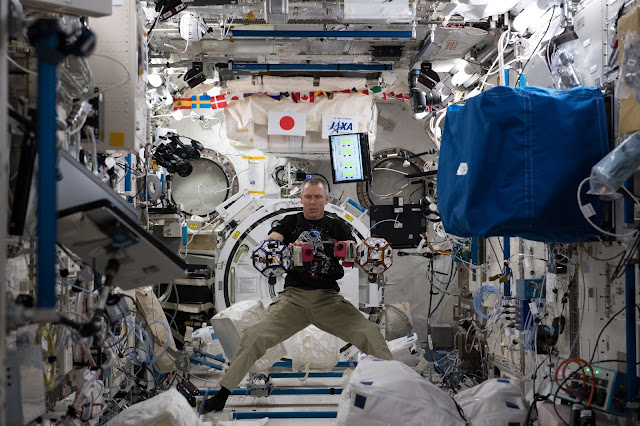ISS - Expedition 55 Mission patch.
April 6, 2018
It has been another exciting week of science aboard the International Space Station. Two days after its Monday launch from Cape Canaveral Air Force Station in Florida, the SpaceX-14 Dragon arrived to the orbiting laboratory with 5,800 pounds of fresh science, hardware and supplies.
This week, Expedition 55 crew members were busy conducting research in the fields of biotechnology, physical science, technology development, education and more.
Animation above: Polar as it is unpacked from the Dragon capsule. Polar is a Cold Stowage managed facility that provides transport and storage of science samples at cryogenic temperatures (-80ºC) to and from the Space Station. Image Credit: NASA.
Following the arrival of SpaceX-14, crew members and ground controls began early activations and transfers of Invitrobone, Multi-use Variable-g Platform (MVP), Fruit Fly Lab-3, Mouse Stress Defense, NanoRacks-NDC-CCSJ-Beta-Amyloid Peptide and Tangolab Payload Card-6, which houses a few different investigations.
Take a look at some of the science that happened this week aboard your orbiting laboratory:
Crew members collect body samples to create baseline standard for station
The Microbial Observatory of Pathogenic Viruses, Bacteria, and Fungi Project (Microbial Tracking-2) investigation seeks to catalog and characterize potential disease-causing microorganisms aboard the space station. The development of an all-encompassing, integrated, comprehensive microbial database enables various strategies of screening for, and identifying, specific subsets of microorganisms. This dataset creates a capability to compare fluctuating viral and microbial communities to "baseline" standards, enables more accurate assessments of crew health associated with a given mission and future mission planning.
Image above: The SpaceX Dragon carried more than 5,800 pounds of science, hardware and supplies to the space station. Image Credit: NASA.
This week, a crew member collected saliva and body samples and inserted them into the Minus Eighty Degree Celsius Laboratory Freezer for ISS (MELFI) for storage before completing a body sample questionnaire.
ACME chamber prepared for initiation of experiment
The Advanced Combustion Microgravity Experiment (ACME) investigation is a set of five independent studies of gaseous flames to be conducted in the Combustion Integration Rack (CIR), one of which being E-Fields Flame. ACME’s goals are to improve fuel efficiency and reduce pollutant production in practical combustion on Earth and to improve spacecraft fire prevention through innovative research focused on materials flammability.
This week, crew members removed the ACME Mesh negative Power Supply and installed the ACME Mesh Positive Power Supply, replaced an ignitor tip and replaced other hardware within the chamber, all in preparation for the next series of data collection with a positive field.
Crew conducts successful trial runs for SmoothNav investigation
Many future space exploration and space-based business enterprise models, such as on-orbit satellite servicing, on-orbit assembly, and orbital debris removal, necessitate the use of fully autonomous multi-satellite systems. Smoothing-Based Relative Navigation (SmoothNav) develops an estimation algorithm aggregating relative state measurements between multiple, small, and potentially differently-instrumented spacecraft.
Image above: NASA astronaut Drew Feustel conducts a test run as a part of the SmoothNav investigation. Image Credit: NASA.
The algorithm obtains the most probable estimate of the relative positions and velocities between all spacecraft using all available sensor information, including past measurements. The algorithm remains portable between different satellite platforms with different onboard sensors, adaptable in the case that one or more satellites become inoperable, and tolerant to delayed measurements or measurements received at different frequencies.
This week, the crew completed 15 test runs without any software errors.
Crew preps JAXA investigation for initiation
Spaceflight brings an extreme environment with unique stressors. Exposure to cosmic radiation increases intracellular oxidative stresses, which can lead to DNA damage and cell death. Microgravity provokes cellular mechanical stresses and perturbs cellular signaling, leading to reduction of muscle and bone density. To overcome these space stresses, one of the promising strategies is to activate Nuclear Factor-like 2 (Nrf2), a master regulator of antioxidant pathway. Mouse Stress Defense, a JAXA investigation, tests genetically modified loss-of-Nrf2-function and gain-of-Nrf2-function in mice in the space environment and examines how Nrf2 contributes to effective prevention against the space-originated stresses.
Space to Ground: A Learning Doubleheader: 04/06/2018
This week, crew members prepped and transferred the investigation from the Dragon capsule.
Other work was done on these investigations: Crew Earth Observations, CBEF, Polar, Veg-03, STP-H5 ICE, METEOR, MSG, Food Acceptability, EarthKAM, HDEV, METEOR, HDEV, SCAN Testbed, Metabolic Tracking, HRF-2, SPHERES Tether Slosh and Lighting Effects.
Related links:
SpaceX-14 Dragon: https://www.nasa.gov/mission_pages/station/research/SpX-14_research_launch_feature
Invitrobone: https://www.nasa.gov/mission_pages/station/research/experiments/explorer/Investigation.html?#id=7355
Multi-use Variable-g Platform (MVP): https://www.nasa.gov/mission_pages/station/research/experiments/explorer/Facility.html?#id=1777
Fruit Fly Lab-3: https://www.nasa.gov/mission_pages/station/research/experiments/explorer/Investigation.html?#id=1774
NanoRacks-NDC-CCSJ-Beta-Amyloid Peptide: https://www.nasa.gov/mission_pages/station/research/experiments/explorer/Investigation.html?#id=7497
Tangolab Payload Card-6: http://www.spacetango.com/blog/2018/4/1/whats-flying-a-look-at-space-tango-crs-14-payloads
Microbial Tracking-2: https://www.nasa.gov/mission_pages/station/research/experiments/explorer/Investigation.html?#id=1663
Minus Eighty Degree Celsius Laboratory Freezer for ISS (MELFI): https://www.nasa.gov/mission_pages/station/research/experiments/explorer/Facility.html?#id=56
Advanced Combustion Microgravity Experiment (ACME): https://www.nasa.gov/mission_pages/station/research/experiments/explorer/Investigation.html?#id=1651
Combustion Integration Rack (CIR): https://www.nasa.gov/mission_pages/station/research/experiments/explorer/Facility.html?#id=317
E-Fields Flame: https://www.nasa.gov/mission_pages/station/research/experiments/explorer/Investigation.html?#id=2058
Crew Earth Observations: https://www.nasa.gov/mission_pages/station/research/experiments/explorer/Investigation.html?#id=84
CBEF: https://www.nasa.gov/mission_pages/station/research/experiments/explorer/Facility.html?#id=333
Polar: https://www.nasa.gov/mission_pages/station/research/experiments/explorer/Facility.html?#id=1092
Veg-03: https://www.nasa.gov/mission_pages/station/research/experiments/explorer/Investigation.html?#id=1159
STP-H5 ICE: https://www.nasa.gov/mission_pages/station/research/experiments/explorer/Investigation.html?#id=1749
METEOR: https://www.nasa.gov/mission_pages/station/research/experiments/explorer/Investigation.html?#id=1174
MSG: https://www.nasa.gov/mission_pages/station/research/experiments/explorer/Facility.html?#id=341
Food Acceptability: https://www.nasa.gov/mission_pages/station/research/experiments/explorer/Investigation.html?#id=7562
EarthKAM: https://www.nasa.gov/mission_pages/station/research/experiments/explorer/Investigation.html?#id=87
HDEV: https://www.nasa.gov/mission_pages/station/research/experiments/explorer/Investigation.html?#id=892
SCAN Testbed: https://www.nasa.gov/mission_pages/station/research/experiments/explorer/Investigation.html?#id=156
Metabolic Tracking: https://www.nasa.gov/mission_pages/station/research/experiments/explorer/Investigation.html?#id=7517
HRF-2: https://www.nasa.gov/mission_pages/station/research/experiments/explorer/Investigation.html?#id=7517
SPHERES Tether Slosh: https://www.nasa.gov/mission_pages/station/research/experiments/explorer/Investigation.html?#id=7381
Lighting Effects: https://www.nasa.gov/mission_pages/station/research/experiments/explorer/Investigation.html?#id=2013
Expedition 55: https://www.nasa.gov/sites/default/files/atoms/files/exp-55-summary.pdf
Space Station Research and Technology: https://www.nasa.gov/mission_pages/station/research/index.html
International Space Station (ISS): https://www.nasa.gov/mission_pages/station/main/index.html
Images (mentioned), Animation (mentioned), Video, Text, Credits: NASA/Michael Johnson/Yuri Guinart-Ramirez, Lead Increment Scientist Expeditions 55 & 56.
Best regards, Orbiter.ch




